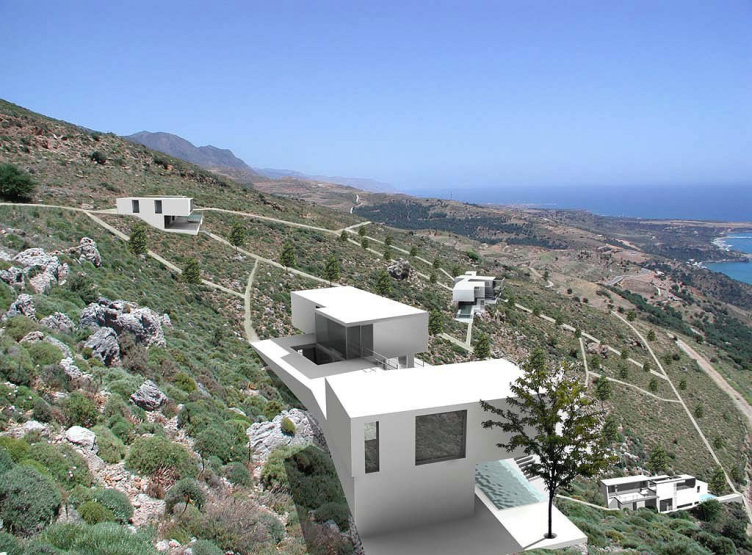The refusal from the ethnic stylistics of modern objects is a novelty for Crete. How do the Russian architects have taken the advantage of the freedom given to them in cultural reservation of the Europe where the historical buildings exist for more than 4000 years? «The super problem of the project, - speaks Aleksandrov, - is to create modern "monument" in the landscape environment of Crete: within absolutely not engaged style searches, the prospect is to define a panorama of world sea cruises ». The zone of natural landscape complex of area of gulf Plakia, limited by the highest hills of Crete Omalos on one side of island is allocated under the construction , but according to town-planning laws of the island a view from the windows of private property could not be broken. The plot of land in 4,1 hectares is located in a natural hollow and on outlines reminds a bird with spreaded wings. However the project got its name dew to the English investors familiar with these picturesque surroundings under the novel of James Oldrige «The Sea eagle» but not to morphology of the plot .According to Englishmen will the plot divides into three zones: 3 hectares - VIP-territory with accommodation of 4 country houses (for investors of the project), 1 hectare – hotel-territory with 13 blocked town houses , 0,1 hectare – buffer border with public function: pier, tavern, market and - an obligatory condition of complex construction on Crete - an orthodox temple. The extreme-tourism and a mobile way of life, spreaded on island, and also strict, but completely not conservative tastes of Englishmen have defined figurativeness of the settlement. Geometrically verified (a right angle - a curve) objects planed to be "reloading points" in which it is possible to hide for a while from the sun, wind and open space prevailing over Crete. Console elements create shadow zones on perimeter of buildings. The space of a private life is hidden inside. The pools in front of the country houses, and also the glass, the nickel-plated metal and crete stone, used in furnishing of structures, transform settlement in gleaming on the sun «a stone loose» on the seaside of Crete and level intervention in a landscape.The refusal from the ethnic stylistics of modern objects in a novelty for Crete. How do the Russian architects have taken the advantage of the freedom given to them in cultural reservation of the Europe where the historical buildings exist for more than 4000 years? «The super problem of the project, - speaks Aleksandrov, - is to create modern "monument" in the landscape environment of Crete: within absolutely not engaged style searches, the prospect is to define a panorama of world sea cruises ». The zone of natural landscape complex of area of gulf Plakia, limited by the highest hills of Crete Omalos on one side of island is allocated under the construction , but according to town-planning laws of the island a view from the windows of private property could not be broken.
The plot of land in 4,1 hectares is located in a natural hollow and on outlines reminds a bird with spreaded wings. However the project got its name dew to the English investors familiar with these picturesque surroundings under the novel of James Oldrige «The Sea eagle» but not to morphology of the plot .According to Englishmen will the plot divides into three zones: 3 hectares - VIP-territory with accommodation of 4 country houses (for investors of the project), 1 hectare – hotel-territory with 13 blocked town houses , 0,1 hectare – buffer border with public function: pier, tavern, market and - an obligatory condition of complex construction on Crete - an orthodox temple.
The extreme-tourism and a mobile way of life, spreaded on island, and also strict, but completely not conservative tastes of Englishmen have defined figurativeness of the settlement. Geometrically verified (a right angle - a curve) objects planed to be "reloading points" in which it is possible to hide for a while from the sun, wind and open space prevailing over Crete. Console elements create shadow zones on perimeter of buildings. The space of a private life is hidden inside. The pools in front of the country houses, and also the glass, the nickel-plated metal and crete stone, used in furnishing of structures, transform settlement in gleaming on the sun «a stone loose» on the seaside of Crete and level intervention in a landscape.







































